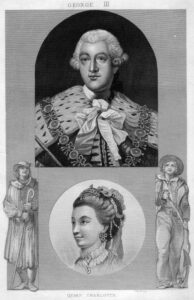
Is the new series accurate to the history that inspired it?
While season 3 of Bridgerton is on the way, fans of the fictional period drama can hold themselves over with Netflix’s new prequel series, Queen Charlotte. The fierce royal steals the screen in the beloved series based on the novels by Julia Quinn, and the new six-episode show follows Queen Charlotte and King George’s love story as well as the external factors that affect their relationship. While most of it is fiction for the sake of creating an enthralling romance on-screen, pieces of Charlotte and George’s characters are based on the real royals who reigned in Britain during the 1700s.
As you tune in to Queen Charlotte: A Bridgerton Story, you may be wondering how much of their story is accurate to the historical events that inspired it. Ahead, find everything we know about Queen Charlotte and King George’s marriage IRL.
Did Queen Charlotte love King George in real life?
In the Netflix series, Charlotte and George got married the first day they met in person at the palace’s garden. This isn’t far off from the events that went down IRL, according to Olwen Hedley’s 1975 book, Queen Charlotte. The real-life George III announced his intentions to marry Princess Charlotte of Mecklenburg-Strelitz in July 1761. She met George in person for the first time in September 1761 and “threw herself at his feet,” which prompted him to carry her through a garden, up the steps, and into his English palace. The 17-year-old German princess became the Queen of the British throne as she married 22-year-old George a few hours after they had met in real life, per the Royal Family’s official website.
The couple moved into Buckingham House in 1762, which eventually became known as the famous Buckingham Palace where the Royals currently reside. Multiple reports note that they even slept in the same bed together, which was not the norm during the era they reigned in. According to the book George III: The Life and Reign of Britain’s Most Misunderstood Monarch by Andrew Roberts, King George was also the first in his family to never have a mistress and stayed faithful to Charlotte throughout their marriage. Roberts even details a moment where he told one of the Queen’s ladies that “The queen is my physician, and no man can have a better; she is my friend, and no man can have a better.”

In August 1762, Queen Charlotte and King George had their first child together — the Prince of Wales, who would later become King George IV. As the Netflix series shows, the monarchs went on to have 15 children with each other in real life. They had nine sons and six daughters, but their two youngest sons died when they were 1 and 4 years old.
Three decades into their marriage, the couple will continue to show affection by writing love letters to each other. “I have this instant been made very happy with Your very Affectionnate [sic] & kind letter, for which I want words to Express both my joy & happiness, but I can say with great Truth that tho my Pen cannot express my feeling my Heart most does most deeply feel,” Charlotte wrote to George in 1797, per the Royal Collection Trust.
The show also depicts King George’s declining mental health as a major plot point that affects his relationship with the Queen and their children. The real King shows symptoms of mania which more closely aligns with bipolar I disorder, per the National Library of Medicine. A medical journal article, “The madness of King George III: a psychotropic re-assessment” by Timothy J Peters, also reveals that in 1765, King George had already shown signs of mild depression at the age of 27.
However, it wouldn’t be until 1788 that King George suffered his first major bout of mental illness at the age of 50. Per the Georgian Papers, the episode scared Queen Charlotte so terribly, she stopped sleeping in the same bed as him. Smithsonian reports that the King barely got sleep, causing him to “speak out of turn” and accusing Charlotte of cheating on him. He allegedly made offensive advances toward her attendants and physically assaulted their oldest son, George, Prince of Wales, according to Georgian Papers.
Historian James P. Ambuske told Smithsonian in 2016 that the King was also “capable of a great deal of empathy” despite his harmful behavior. “He was very concerned, as any parent would be, about the well-being of his children and their education. He was well aware that he was raising potential future sovereigns, but he also wanted them to be good people.”
In February 1811, the Prince of Wales officially became Regent as the King’s conditions grew worse and he showed signs consistent with chronic mania and dementia. Per Vogue, one of the King’s physicians Robert Willis wrote, “We have seen His Majesty sometimes in a state of delirium, sometimes strongly impressed by false images, neither of which states has characterised this day so much as a degree of irritability, which could only be met by coercion, and which was only varied by occasional exclamations and noises without meaning,” in September 1811.
During this time, Charlotte became George’s permanent guardian and stayed by his side until she died of pneumonia in 1818, when she was 74 years old. The King actually outlived the Queen, as he died at Windsor Castle on January 19, 1820, after a nearly 60-year reign — the third longest in British history.
